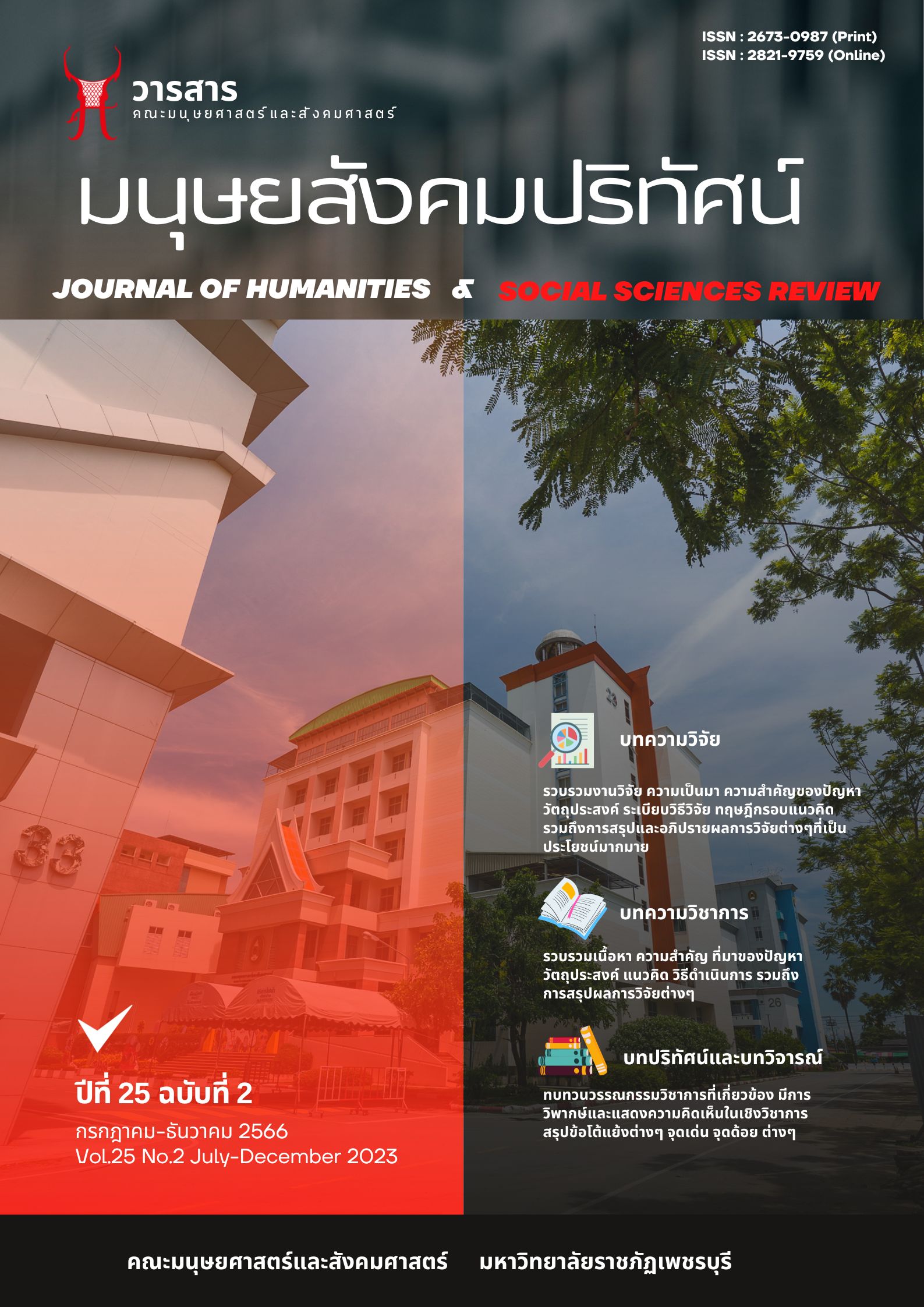Sustainable Community-Based Tourism Management at Ban Huai Hom, Huai Hom Sub-district, Mae La Noi District, Mae Hong Son Province
Main Article Content
Abstract
The purpose of this research was to study the operation and development of community-based tourism management at Ban Huai Hom, Huai Hom sub-district, Mae La Noi district, Mae Hong Son Province. The total number of research population were 376 people. The samples of the research population were the head of the family in the household of 105 households, and the sample group were people involved in CBT of 10 people including municipal mayor, sub-district administrative organization members, community tourism coordinator, philosopher in the community, village headman, village headman's assistant, agricultural group, homestay group, weaving group and agricultural products processing group. The topics in the study were consisted of 4 major aspects which were natural resources and culture, community organization, management and learning. The results of the study revealed that the factors affecting on community-based tourism management operations at Ban Huai Hom were 1) number of tourists visiting, 2) the community’s increase income and fair income distribution, 3) the community’s better quality life, 4) environmental conservation in the community, 5) preserving local arts and culture. However, the key elements that affected the sustainable community based tourism management were 1) strategic planning of those involved in the community, 2) management of tourism resources in terms of natural beauty and cultural heritage, 3) service quality management, 4) community leadership, 5) social capital, and 6) The support from external organizations both the public and private sectors.
Article Details
1. Any views and comments in the article are the authors’ views. The editorial board has not to agree with those views and it is not considered as the editorial board’s responsibility. In case, there is any lawsuit about copyright infringement, it is considered as the authors’ sole responsibility.
2. The article copyright belonging to Faculty of Humanities and Social Sciences, Phetchaburi Rajabhat University are copyrighted legally. Republication must be received direct permission from the authors and Phetchaburi Rajabhat University in written form.
References
กระทรวงการท่องเที่ยวและกีฬา. (2565). สถิติด้านการท่องเที่ยว. สืบค้นเมื่อ 4 กรกฎาคม 2561, จากhttps://www.mots.go.th/news/.
กิจจา บานชื่น. (2561). หลักการจัดการ. กรุงเทพฯ: ซีเอ็ดยูเคชั่น.
กำธร ชมพนา และสุชาติ แก่นจิง. (2565). สุดยอดชุมชนต้นแบบเที่ยวชุมชนยลวิถี. รองนายกองค์การบริหารส่วนตำบลห้วยห้อม, องค์การบริหารส่วนตำบลห้วยห้อม. สัมภาษณ์.
ไกรลาศ ปสุวัฒนกุล. (2550). การท่องเที่ยวชุมชน. สืบค้นเมื่อ 5 กรกฎาคม 2561, จาก https://www.chiangmainews.co.th.
บุญเลิศ จิตตั้งวัฒนา. (2548). การพัฒนาการท่องเที่ยวแบบยั่งยืน. นนทบุรี: เพรส แอนด์ดีไซน์.
พจนา สวนศรี. (2554). คู่มือการจัดการท่องเที่ยวโดยชุมชน. กรุงเทพฯ: โครงการท่องเที่ยวเพื่อชีวิตและธรรมชาติ.
พรพิมล เมธาลักษณ์. (2549). การติดตามระบบนิเวศอย่างมีส่วนร่วม: บทเรียนปัจจุบันสู่ทิศทางในอนาคต. กรุงเทพฯ: ศูนย์ฝึกอบรมวนศาสตร์ชุมชนแห่งภูมิภาคเอเชียแปซิฟิก.
พิชาย รัตนดิลก ณ ภูเก็ต. (2552). องค์การและการบริหารจัดการ. นนทบุรี: ธิงค์ บียอนด์ บุ๊คส์.
มะลิวัลย์ นักรบไพร. (2565). ชุมชนต้นแบบปลอดการเผา. รองประธานกลุ่มกาแฟบ้านห้วยห้อม. บ้านห้วยห้อม อำเภอแม่ลาน้อย จังหวัดแม่ฮ่องสอน. สัมภาษณ์.
สมศักดิ์ สามัคคีธรรม. (2560). สวัสดิการชุมชนกับการสร้างสังคมเข้มแข็งในเขตกรุงเทพมหานคร. วารสารร่มพฤกษ์, 35(1): 151.
สุบิน กระจ่างเนตร. (2565). สุดยอดชุมชนต้นแบบเที่ยวชุมชนยลวิถี. นายกองค์การบริหารส่วนตำบลห้วยห้อม, องค์การบริหารส่วนตำบลห้วยห้อม. สัมภาษณ์.
อังคณา นักรบไพร. (2565). ผ้าทอขนแกะ. ชาวปกาเกอญอที่บ้านห้วยห้อม อำเภอแม่ลาน้อย จังหวัดแม่ฮ่องสอน. สัมภาษณ์,
อานัน พงศ์พิมล. (2565). สุดยอดชุมชนต้นแบบเที่ยวชุมชนยลวิถี. รองนายกองค์การบริหารส่วนตำบลห้วยห้อม, องค์การบริหารส่วนตำบลห้วยห้อม. สัมภาษณ์.
Bourdieu, P. (1977). Outline of a theory of practice. Cambridge: Cambridge University Press.
Bramwell, B., Higham, J., Lane, B., and Miller, G. (2017). Twenty-five years of sustainable tourism and the Journal of Sustainable Tourism: Looking back and moving forward. Journal of Sustainable Tourism, 25(1): 1–9. Retrieved July 12, 2018, from https://doi.org/10.1080/09669582.2017.1251689.
Denman, R. (2001). Guidelines for community based ecotourism development. Washington: Mc Graw-Hill.
Emery, M.E., and Flora, C. (2006). Spiraling-up: Mapping community transformation with community capitals framework. Community Development, 37(1): 19-35.
Moscardo, G., and Murphy, L. (2014). There is no such thing as sustainable tourism: Re-conceptualizing tourism as a tool for sustainability. Sustainability (Switzerland), 6(5): 2538–2561. Retrieved July 12, 2018, from https://doi.org/10.3390/su6052538.
Okazaki, E. (2008). A community-based tourism model: Its conception and use. Journal ofSustainable Tourism, 16 (5): 511-530.
Weaver, D.B. and Lawton, L.J. (2007). Twenty years on: The state of contemporary ecotourism research. Tourism Management, 28: 1168-1179. Retrieved July 12, 2018, fromwww.ethioembassy.org.uk/trade_and_investment/Tourism_2010.pdf.


